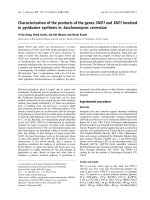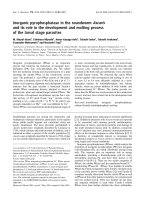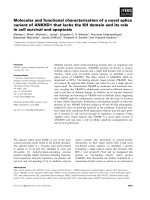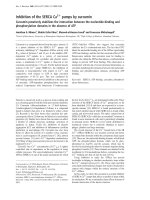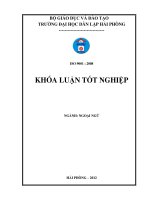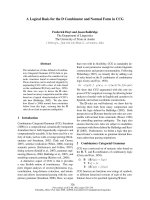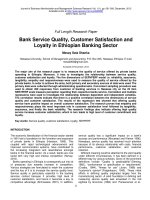Assecting the sevice quality and customer satifation in retail banking sector from customers perspective AC between state owned commercial banks ang jonit stock commerical banks in hochiminh city
Bạn đang xem bản rút gọn của tài liệu. Xem và tải ngay bản đầy đủ của tài liệu tại đây (1.57 MB, 77 trang )
UNIVERSITY OF ECONOMICS HO CHI MINH CITY
International School of Business
Nguyen Thi Quynh Trang
ASSESSING THE SERVICE QUALITY AND CUSTOMER
SATISFACTION IN RETAIL BANKING SECTOR FROM
CUSTOMERS PERSPECTIVE: A COMPARISON BETWEEN
STATE-OWNED COMMERCIAL BANKS AND JOINT-STOCK
COMMERCIAL BANKS IN HOCHIMINH CITY
MASTER OF BUSINESS (Honours)
Ho Chi Minh City – Year 2014
UNIVERSITY OF ECONOMICS HO CHI MINH CITY
International School of Business
Nguyen Thi Quynh Trang
ASSESSING THE SERVICE QUALITY AND CUSTOMER
SATISFACTION IN RETAIL BANKING SECTOR FROM
CUSTOMERS PERSPECTIVE: A COMPARISON BETWEEN
STATE-OWNED COMMERCIAL BANKS AND JOINT-STOCK
COMMERCIAL BANKS IN HOCHIMINH CITY
ID: 22110068
MASTER OF BUSINESS (Honours)
SUPERVISOR: Dr. DINH CONG KHAI
Ho Chi Minh City – Year 2014
ACKNOWLEDGEMENT
I would like to send my appreciation to Dr. Dinh Cong Khai, who has supported me through my
thesis.
I would like to send my thanks to ISB-UEH staff that have facilitated my thesis.
Moreover, I also want to send my thanks to my friends who supported me in discussing initial
questionnaire and respond to my survey.
Finally, it would be impossible to say enough about my dear parents and my brother for all of
their understanding, encouragement, and advice which helped me to complete this research in
time.
Nguyen Thi Quynh Trang
ABSTRACT
There are many studies recognized that service quality has a strong correlation with
customer satisfaction. This research aims to assess and compare the service quality between two
types of commercial banks: the state-owned banks and joint-stock banks. Although the state-
owned banks outperform the joint-stock banks in many areas such as capitals, customers,
profitability; but many researches showed that the joint-stock banks have higher levels of service
quality perceived by the customers.
Based on the BSQ scale developed by Bahia and Nantel (2000) which included six
dimensions of service quality, survey questionnaires were issued to capture the customers’
perspective about how they satisfy with service offered by these two types of banks.
The result shows that there are significant differences between two types of banks in term
of customer satisfaction and the degree of important attached to various dimensions of service
quality. The result also suggested that the type of banks affect level of customer satisfaction.
This study has some implications for state-owned banks to recognize their weakness in
management system, and HR strategies.
Key words: service quality, customer satisfaction, retail banking service.
TABLE OF CONTENTS
CHAPTER 1: INTRODUCTION
1.1 Research background and problem statement 1
1.2 Research question 4
1.3 Research scope and significant of the study 4
1.4 Methodology 5
1.5 Structure of the research 6
CHAPTER 2: LITERATURE REVIEW 7
2.1 Retail banking services 7
2.2 Service quality 9
2.2.1 Service quality definition 9
2.2.2 Service quality and customer satisfaction 10
2.2.3 Measuring service quality 12
2.2.3.1 Service quality dimension 12
2.2.3.2 The SERVQUAL model 13
2.2.3.3 The BSQ scale 17
2.2.3.4 The research hypotheses 18
CHAPTER 3: RESEARCH METHODOLOGY 24
3.1 Research design 24
3.1.1 Research method 24
3.1.2 Sampling 25
3.1.2.1 Sample size 25
3.1.2.2 Sampling method 26
3.2 Research scale 27
3.3 Data analysis approaches 31
CHAPTER 4: DATA ANALYSIS 35
4.1 Statistics on sample 35
4.2 Cronbach’s alpha analysis 35
4.3 Exploratory Factor Analysis (EFA) 37
4.4 Regression analysis 41
4.5 Independent Sample-t Test 46
CHAPTER FIVE: DISCUSSION, RECOMMENDATION AND CONCLUSION 49
5.1 Discussion on research findings 49
5.2 Implication of this study and recommendation 50
5.3 Research limitation and suggestion for further research 52
CONCLUSION 53
REFERENCES i
APPENDIX v
List of tables
Table 1 Total charter capital of Vietnamese banks 1
Table 2 Scale measurement for Effectiveness and Assurance 28
Table 3 Scale measurement of Access 29
Table 4 Scale measurement of Price 29
Table 5 Scale measurement of Tangibles 30
Table 6 Scale measurement of Service portfolio 30
Table 7 Scale measurement of Reliability 31
Table 8 Scale measurement of Customer satisfaction 31
Table 9 Cronbach’s alpha test of items 36
Table 10 EFA result (time 1) 38
Table 11 Final EFA result 40
Table 12 Coefficients model 1 43
Table 13 Coefficients model 2 44
Table 14 Coefficients model 3 45
Table15 Independent Sample-t test 47
Table 16 Summary on testing hypotheses 48
Table 17 Testing Cronbach’s alpha for pilot test viii
Table 18 Frequency statistics ix
Table 19 Cronbach's alpha for Access ix
Table 20 Cronbach’s alpha (after running EFA time 3) x
Table 21 Factor loading for the rotated factors (time 1) xi
Table 22 Independent variable correlation xii
Table 23 Coefficients for moderating variable xii
Table 24 Group statistics for Independent Sample –t test xiii
List of figures
Figure 1 Customer satisfaction measurement method 12
Figure 2 Gap analysis model 14
Figure 3 Research model 22
Figure 4 Research process 26
Figure 5 Scatterplot 42
Figure 6 Regression standardized residual xiv
Figure 7 Normal P-P Plot of Regression standardized residual xv
1
CHAPTER 1: INTRODUCTION
1.1 Research background and problem statement
After seven years since Vietnam has become a member of World Trade Organization
(WTO), the economy has achieved initial successes. The environment and activities of the
Vietnamese Banking systems has improved in structures, human resources, service quality… Up
to June 2013, the Vietnamese banking system has five state-owned banks including:
Vietcombank, Vietinbank, Agribank, BIDV, MHB. Right from the early 2000s, the government
has planned to equitize state-owned commercial banks following the main principle that state
holds controlling stakes in order to improve management and financial capability, compliant
with standards and international practices; create favorable conditions for commercial banks to
develop rapidly, improve its competitiveness and hold a large market share, dominates. In
December 2007, Vietcombank was the first state-owned bank officially listing shares on the
HOSE Exchange, marked the first step of the equitization of state-owned commercial banks.
After that, Vietinbank (December 2008), MHB (July 2011), BIDV (December 2011) were
successfully equitized, confirmed the right step of government in the process of equitizing state-
owned banks.
The Vietnamese banking system also has 35 joint-stock commercial banks, in which
have high charter capital such as: Eximbank, Techcombank, ACB, Sacombank, MB,…; five
wholly foreign-owned banks, four joint-venture banks and more than fifty branches of foreign
banks. This figure is not small in compare to a developing country as Vietnam, which has made
the competition in banking market very fierce. The Financial Magazine No.5 (2013) stated that:
“… The commercial banks in Vietnam, both state-owned banks and joint-stock banks,
aim to develop retail banking service, which are shown in the plan to restructure or
equitized banks…Most of the state-owned banks have a wide network of branches and a
2
huge system of traditional customers for years. The joint-stock banks develop mainly
based on individual customers, small and medium enterprises…”
()
Many studies supported the view that public organizations which receive large funding
from government are less profitability, productivity and performance efficiency, and so do not
better serve than private organizations (Bei and Shang, 2006; Kangis and Kareklis, 2001). Data
of banks in Vietnam showed that the state-owned commercial banks have greater financial
resources, size and the major capital contribution from the state, operating primarily in the
wholesale sector and then focusing on developing retail services. The joint-stock commercial
banks are smaller in financial strength, but focus on the retail market from the beginning could
also have certain advantages.
Table 1 Total charter capital of Vietnamese banks
Charter Capital
Number of banks
Group 1
> VND 20 trillion
4 (State-owned banks)
Group 2
VND 5 Trillion - 20 Trillion
11 (including some
Joint-stock banks in this research)
Group 3
VND 3.5 Trillion - 5 Trillion
7
Group 4
< VND 3.5 trillion
11
Source: www.kpmg.com.vn
38%
38%
12%
12%
Total charter capital
(31/12/12)
Group 1
Group 2
Group 3
Group 4
3
Berry et al (1988) stated that the services that banks offer to their customers are quite
similar in design, and the prices are comparable, but banks were different in the level of service
quality. When the types of products and services of the banks are similar and there is no
significant difference, the quality of services may become a strategic weapon that can help banks
overcome rivals in order to capture the market. There are no common standards or criteria for
evaluating or ranking retail banks. In fact, banks in Vietnam have ranked or assessed but only
through the vote of some Bank Magazine by particular criteria such as the ability to generate
soared retail sales, leading on profits from business operations and customer growth (the Asian
Banker); or criteria based on the assessment of innovation and efficiency (the Asian Banking &
Finance). However, if based on the criteria above, a number of banks which have the advantages
of size, financial resources (mainly state-owned commercial banks) will have more advantages.
In addition, the criterion by consumers voted is not focused.
Based on those advantages and literature studies, do Vietnamese banks actually exploit
and utilize effective or not, do joint-stock banks better serve than state-owned banks are essential
questions that need to be obtained in the research: “Assessing the Service Quality and
Customer Satisfaction in Retail Banking Sector from Customer Perspectives: a
Comparison Between State-owned Commercial Banks and Joint-stock Commercial Banks
in Ho Chi Minh city”. In recent years, commercial banks in Vietnam have made great strides in
developing banking services. Developing retail banking services is a trend for banks to
strengthen their current presence, increase market share, and enhance the competitiveness of
banks. Many banks actively expand retail distribution channels through opening branches and
transaction offices to meet the increasing demand of customers. Vietnamese commercial banks
not only focus on the rapidly expanding distribution channel to access retail market share, but
also promote the application of information technologies, improve service quality, increase the
4
usability of the service to the customer’s accounts. Therefore, banks can improve their operations
as well as consolidate their images in customers’ eyes, and banks can increase sales, market
share, and position in the market. Besides, knowing what customers need, what they expect and
how they feel about the service they have received is important for banks to evaluate their
service. Searching customers’ satisfaction in the bank is an important task that has to be done
regularly and continuously in order to meet their needs. Since then, they can serve customers
better and make customers always be satisfied when using bank’s products and services.
1.2 Research question
The purpose of this research is to assess the service quality that customers perceive and
compare the service quality between two types of bank in Vietnam: state-owned commercial
banks and joint-stock commercial banks.
Doing this research, we can answer these questions:
1. Is there a significant relationship between the perceived service quality and customer
satisfaction among retail banking customers in Ho Chi Minh city?
2. Are there significant differences on service quality form customers’ perspective between
two types of banks: State-owned commercial banks and joint-stock commercial bank?
3. Do types of banks affect customer satisfaction related to the degree of importance
attached to the various dimensions of service quality?
1.3 Research scope and significant of the study
There are many banks in Ho Chi Minh city which vary from sizes, capital
resources…Besides, retail banking services aim to serve individual and small – medium
enterprises. In this study I just conduct survey on individual customers who used services from
two types of banks. Vietcombank, Vietinbank and BIDV were chosen from state-owned
5
commercial banks since they were equitized. For joint-stock commercial banks, some banks that
have high chartered capital such as Techcombank, Sacombank, ACB, Eximbank, were chosen.
They are all located in Ho Chi Minh city.
The study planned to impact the success of the growing retail banking sector in a
transition economy through analyzing customer reactions to the service quality by examining
their levels of satisfaction with specific service quality dimensions. Analyzing the level of
service quality from customers’ perception, the banks will better understand customers’ needs
and quality of services that they provide, know strengthens - weaknesses and the position of
banks.
1.4 Methodology
A survey instrument using a 7-point Likert-type format was designed to collect
participant perceptions to conduct statistical comparison. The study includes two stages: (1) the
pilot study used both qualitative and quantitative method. In the pilot study, based on the original
BSQ scale, a preliminary questionnaire was developed. 10 people were interviewed in order to
edit and confirm that all the questions are well-understood. The result of this step is to build a
questionnaire used in formal study. The formatted questionnaire was sent to 52 customers to test
the reliability of scale by using quantitative method. (2) The formal study used quantitative
method to collect and analyze survey data, as well as to test the hypotheses. In the formal study,
the reliability of the data was tested by Cronbach’s alpha technique. Then the study tested scales
measurement validity: factor analysis - EFA (Exploratory Factor Analysis) and apply some
technique such as Independent samples t-Test to identify if there are significant difference from
service quality between two type of banks. Multiple regression analysis was used in an attempt to
6
demonstrate the impact of service quality dimensions in explaining overall satisfaction of
customers in retail banking sector.
1.5 Structure of the research
The structure of this study includes five chapters. Chapter One introduced the research
background and problem statement, research question and scope of the study. The methodology
was also briefly introduced in this chapter.
Chapter Two reviewed the concept of retail banking service, service quality definition
and assessment. Hypotheses and research model were then given based on literature review.
Chapter Three introduced the research methodology with sample selection; scale
development was presented in detail in this chapter.
Data collected was then calculated and discussed in Chapter Four. By using the SPSS
software, statistics on respondents geographic was presented firstly, then the study tested the
reliability and validity of variables through Cronbach’s alpha and EFA technique. The linear
regression and Independent Sample-t test were used to test hypotheses. Some discussions were
given based on results.
In Chapter Five, recommendation, limitation and suggestion for future research were also
presented.
7
CHAPTER 2: LITERATURE REVIEW
Many studies showed that excellent service has become a competitive weapon for firms.
Organizations in service industry such as banks should consider service quality as a key strategy
for the success of business (Lewis, B. R. and Mitchell, V. W., 1990; Spathis et al., 2004).
Therefore, banks have improved on service quality scale development, capital resources, human
resources and technology to create competitive advantages.
This chapter presents the literature on the concept of service quality, retail banking
service, service quality assessment and measuring service quality in the banking context.
Hypotheses will also be given within literature.
2.1 Retail banking services
“Retail banking is the cluster of products and services that banks provide to consumers
and small businesses through branches, the Internet and other channels” (Timothy et.al, 2007,
p.40). According to this definition, retail banking includes three dimensions: customer served
products and services offered, and the delivery channels linking customers to products and
services.
Retail banking aims to serve individuals and small businesses. With the huge number of
people, banks must identify the right customers segment suitable with banks’ strength. This is
crucial to the success or failure of banks in such a competitive market. About products and
services, Orlow et al (2007) mentioned some activities in both assets and liabilities side of the
balance sheet. For liabilities’ side, deposit taking – which includes transaction deposits such as
current accounts or checking accounts, non-transaction deposits saving accounts and time
deposits – as the core retail banking activities. Many banks emphasized the importance of
deposits, especially checking deposits, in the development of retail banking. Through those
8
accounts, banks can take advantages from customers’ idle money; take fees from many
transactions such as bills payments, money transfer, annual fees…
From the assets’ side, the key retail banking activities are consumers’ credits and small
business loans. They include credit cards, mortgages, home equity lending, auto loans, education
loans and other loans. Aside from loans and deposits, there are a wide range of other financial
services that banks can offer their customers: mutual funds, insurance brokerage, retirement
planning, payroll…
The third dimension of retail banking which links customers to products and services is
delivery channels. It is easy to see that branches network is the main and important channel that
links directly customers to their services. According to Shah and Clarke (2009), the traditional
banking business model is based on physical distribution channel, with numbers of branch
allocated around populated areas to provide a wide range of services. This could help banks to
move closer to customers, encourage them to use banks’ service since there are many activities
required customers to go directly to the banks in order to make transactions such as open new
account, change information, withdrawal or deposit huge amount of money…. Beside, banks
recently develop their remote delivery channels such as ATMs, call centers, the Internet. The
appearance of ATMs network brings convenience of cash using to customer. Fraering and
Minor (2006) argued that current account play a fundamental role between banks and customers.
Through this type of account, people could do many transactions such as money transfer,
electric/ phone payment, credit… Another distribution channel suggested by Shah and Clarke
(2009) is telephone banking and e-banking, which create more convenience to customers. By
providing those utilities, banks could take advantages of the money from the very large number
of customers with low cost, charge collection; and customers gain the convenience. Those
channels provide more convenience to customers; therefore attract more and more customers to
9
use banks services. Based on those structure and benefits, many banks nowadays aim to develop
the branches system, ATM network, e-banking services in order to take advantages in such a
competitive market.
All three dimensions above are interrelated, they must be viewed together to understand retail
banking completely, as suggested by Timothy (2007).
2.2 Service quality
2.2.1 Service quality definitions
Service quality concept has become more popular and important nowadays, not only on
service industries. There were many definitions of the term “service quality” given by different
authors by sharing one or more elements, and based on these definitions, different approaches
were developed to measure service quality in specific context. Many researchers agreed that
service is intangibles activities because unlike goods and products, service has no physical
presence. Gummesson (1987) stated that “services are something that can be bought and sold but
which you cannot drop on your foot” (p.22). Parasuraman (1985) defined services as the benefit
that one party can offer to another.
Although service is intangible, but it has some characteristics that can be evaluated such
as: delivery, consistency, customization, speed, trust That are benefits that customers receive
from the service provider, and base on them, customers will evaluate the quality of service. In
addition, service cannot be assessed prior to its use; customers will rely on his or her experience
of the service to have their judgments.
Definitions using the comparison between expectation and delivered service (or
perception) were the most popular. Representative of the North American School, Parasuraman,
10
Zeithaml and Berry (1990) gave an opinion that “service quality, as perceived by customers, can
be defined as the extent of discrepancy between customers’ expectations or desires and their
perceptions” (p.19). Lewis (1991) also used the concepts “consumers’ expectations and
perception of actual service performance” (p.53) to define service quality. Gronroos (1991)
stated that “consumers compare their expectations with service they perceive” (p.38) to evaluate
service quality. And it can be understood that if performance is higher than expectation, the level
of service quality is high and vice versa.
Having the same attitude but different approach with the above researchers, Cronin and
Taylor (1992) suggested a performance-only measurement for service quality, they stated that
“perceived service quality is best conceptualized as an attitude” (p.58).
Different researchers have different definitions about service quality. So understanding
many definitions and relationships among these main aspects above is useful for firms to set
appropriate structure.
2.2.2 Service quality and customer satisfaction
There are many definitions of customer satisfaction that are accepted. Westbrook (1981)
considered satisfaction as the customer’s evaluation of service provided from their experiences.
Churchill and Suprenant (1982) stated the concept that satisfaction is the outcome of purchase
and use of consumer in compare with their anticipated costs of purchase. Literature also showed
that there is a relationship between customer satisfaction and service quality. Some researchers
mentioned that customer satisfaction is an antecedent of service quality (Parasuraman et al, 1988;
Bitner, 1990; Carman, 1990). In contrast, Cronin and Taylor (1992), Anderson and Sullivan
(1993) argued service quality is an antecedent of customer satisfaction. They indicated that
service quality has positive impact on customer satisfaction. In banking sector, there were studies
11
that also indicated that service quality is positively related to customer satisfaction (Amin and
Isa, 2008; Othman and Owen, 2001). Cronin et al (2000) used some definitions to describe the
relationship between customer satisfaction and service quality, which were: customer satisfaction
is the result of customer’s perception of value perceived, and value equals to perceived service
quality, or the determinant of customer satisfaction is perceived quality. Cronin and Taylor
(1992) suggested that service quality should be viewed as the determinant of customer
satisfaction. Although service quality and customer satisfaction are conceptually distinct, these
two concepts are closely relate constructs. The following figure illustrates customer satisfaction
measurement:
Figure 3 Customer satisfaction measurement method
Source: FeclikovaA Ingrid (2004)
This figure showed that there is a relationship between service quality and customer
satisfaction. Customers’ expectation and quality perceived are the components of service quality
definition; while “service quality has strong influence on overall satisfaction” (Culiberg and
Rojsek, 2010, p.152). Many research indicated a positive and significant association also existed
12
between customers’ satisfaction and service quality (Jamal and Nasser, 2002, Amin and Isa,
2008, Bei and Shang, 2006)
2.2.3 Measuring service quality
2.2.3.1 Service quality dimension
Quality is seemed to be one of the most important things in organization’ success and this
is not an exception for banking sector. As many researchers defined, the common characteristics
of service is intangible that it cannot be seen directly and not easy to measure (Parasuraman et
al., 1988; Stanton, 1986;…)
Parasuraman (1985) defined service as the benefit that one party can offer to another that
are essentially intangible. Service has no physical presence, so how to measure service quality?
Even service is intangible, it has some characteristics that can be assessed, for example, the
delivery channels, the consistency, the speed or accuracy of service offered (Palmer, 2008).
Along with definitions of service quality and service characteristics, many researchers
proposed some models and criteria to assess the quality of services. Because customers
nowadays with high requirement, they do not just buy products and services, they buy value - the
total package of product performance, access, experience, and cost (Jelena et al, 2012). So to
measure service quality, most researchers focused on those dimensions. Parasuraman (1985)
based on their studies with customers and service providers, gave ten determinants of service
quality, they are: reliability, competence, responsiveness, tangibles, credibility, access, security,
communication, courtesy and knowing and understanding customer. Then in 1988, ten
dimensions were consolidated into five dimensions, which were: assurance, responsiveness,
tangibles, empathy and reliability. The SERVQUAL model was then developed base on those
dimensions.
13
Gronroos (1984) built a service quality model with two dimensions (in some case are
three, including image). Technical quality (outcome) refers to what customers receive by
interacting with the service provider. Functional quality (process) refers to how service provider
performs or delivers a service. Image refers to company’s image and how customers perceive the
firm (Gronroos, 2007). In some cases, Gronroos considered image as a dimension, some case
image were considered as a factor that affect technical quality and functional quality. This model
placed an important on customers’ perception of the way the service was delivered.
Guo et al. (2008) developed a new measurement of service quality in banking sector in
China based on SERVQUAL and gave four dimensions: reliability, human capital,
communication, technology. Another study in banking sector done by Othman and Owen (2001)
modified SERVQUAL to measure the service quality by six dimensions: compliance with
Islamic law, assurance, reliability, tangibles, empathy and responsiveness.
The important thing in developing service quality model is that service quality must be
measured from customers’ perspective. Within the literature review, the most popular service
quality model was given by the North American school.
2.2.3.2 The SERVQUAL model
The most widely known service quality model is the Gap Analysis model, which was
developed by Parasuraman, Zeithaml and Berry (1985, 1988) from the North American school.
This model is based on five gaps with gap 1 – 4 were called provider gap and swere internal gaps
caused by organization (Parasuraman et al., 1988; Wilson et al., 2008). Gap 5 was called
consumer gap, which was the most important gap that need to be closed. The SERVQUAL
model derived from gap 5 is used popularly by many researchers in service sector.
14
Figure 1 Gap analysis model
Source: Parasuraman, Zeithaml and Berry, 1985
Gap 1: Consumer expectation – management perception gap
This gap is the result of the difference between consumer expectation and management
perception. Lacks of proper market/ customer focus, lack of communication between managers
… are some reasons that cause gap 1. To close or reduce this gap, adequate marketing research,
improve communication to know customers’ expectation should be done.
Gap 2: Service quality specifications gap
This gap is the result of the difference between management perception of customers’
expectation and the organization’s service quality specifications. This means the management is
unable to translate customers’ expectation into organization’s specifications. Factors that
15
contribute this gap can be: inadequate management commitment, perception of infeasibility,
inadequate standardization, absence of goal setting (Jame, B. B., 2005)
Gap 3: Service delivery gap
This gap is the result of the difference between service quality specifications and actual
service delivery. This gap may be caused by lack of guidelines for service delivery, front-line
staff who are responsible for service delivery are not well supported and trained, poor technology
– job fit… Knowing this is necessary for reducing this gap by provide proper training and
supervision to the staff.
Gap 4: External communication gap
This gap is the result of the difference between actual service delivery and external
communication about service. External communications such as marketing, advertising,
promotion… create the consumers’ image and expectation about the service. If the real service
offered to customers is not as good as what were advertised, customers can become frustrated.
To reduce this gap, communication between advertising and operating department; between sales
personnel, marketing and operating department should be adequate in order to ensure that
employees do not promise more than what can be delivered.
Gap 5: Expected – perceived service gap
This gap is the difference between the expectation of service and the service perceived by
customer. This is the most important gap that needs to be closed to improve the service quality.
Because the size of gap 5 is affected by gap 1 to 4, so reduce gap 1 to 4 is necessary for close gap
5 in turn.
16
By defining service quality as the differences between expectation and performance,
Parasuraman (1985) gave the “gap analysis” measurement and applied components scale to
assess service quality (SERVQUAL). This is the most well-known and popular scale which was
used by many researchers in assessing quality service in a wide range of service sector.
SERVQUAL model is built based on the evaluation of quality of services, which is the
comparison between the expected value, expectation, and the value customers perceived.
SERVQUAL model includes five criteria – reliability, responsiveness, tangibles, assurance, and
the empathy with 22 items to develop both expectation and perceived performance
(Parasuraman, 1988).
Tangibles focus on the elements that represent the service physically. Tangibles are the
images of the facilities, equipment, machines, attitude of staffs, materials, manuals, and
information systems of the bank. General speaking, anything that customers can see by eyes and
feel by senses can impact on tangible.
Reliability refers the ability to deliver the promised service dependably and accurately.
Reliability shows the ability to provide services accurately, on time, and credibly. This requires
consistency in the implementation of services and respects commitments as well as keeps
promises to customers.
Responsiveness is the willingness to help customers and provide prompt service. This
criteria measures the ability to solve the problem fast, deal with customers’ complaint effectively
and the willing to help customers as well as meet the customers’ requirements. In other words,
responsiveness is the feedback from banks to what customers want.
Assurance relates the ability to inspire trust and confidence. This element creates
credibility and trust for customers, which is considered through professional services, excellent
17
technical knowledge, attitude courtesy, and good communication skills, so that customers can
believe in the quality of bank’s services.
Empathy relates to emotional aspect of service. Empathy is the caring, consideration, and
the best preparation for customers, so that they can feel as “guests” of the bank and are always
welcome at any times, anywhere. Human factors are the core of this success and the more caring
the bank gives to customers, the more customer understanding increases.
The SERVQUAL focuses on gap 5 of the Gap Analysis model which was defined as the
difference between expected service and service perceived by customer. Accordingly, service
quality is measured by the equation: “Q = P – E, (Q: quality, P: perception, E: Expectation)”
(Parasuraman, p19). This model measures expectation and perception separately, and this causes
some criticism. Using equation Q = P – E with the concept of “subtraction” has no equivalent
theories of psychological function. Additionally, when using SERVQUAL to interview
customers, it may take long time and inaccurate answer because they have to separate and
answer two times for expectation and perception. Cronin and Taylor (1994) developed a
performance-based measure of service quality labeled SERVPERF. They thought that
‘performance’ rather than ‘perception-expectation’ determines service quality and provides
substantial evidence to show: expectations have little or no impact on the evaluation of
consumers, particularly in relation to service quality (Cronin and Taylor, 1992). This model
followed SERVQUAL scale with the same 22 items defined five dimensions, just excluded the
expectation component from measuring service quality.
2.2.3.3 The BSQ scale
SERVQUAL has been known as the universal model in measuring service quality in a
wide range of service sectors. Many studies applied SERVQUAL in banking sector and
